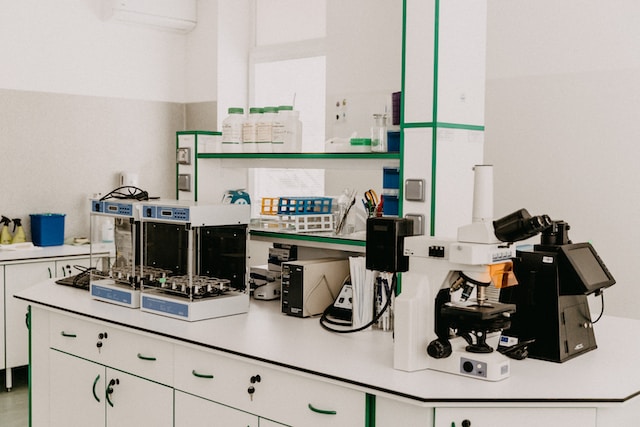Selecting the ideal type of assay method for your individual needs of any particular clinical laboratory scenario requires multiple steps, beginning with seeing the applicable boundary conditions and ending with selecting from among the available types of assay that best satisfy those conditions.
Read on to learn what the different types of assay available are. The main assay types are broken down within four different categories mentioned in this article including: chemical, bioassay, immunoassay, and microbiology.
No matter which assay format is chosen, it is critical that it be calibrated using an accurate calibration curve in order to distinguish between true and false results. This ensures accurate discrimination of true from false results by the assay.
Read on to learn more about the different types of assay available:

Table Comparing Different Assay Methods
Certainly! I’ll expand the table to include a more comprehensive range of assay types across various scientific disciplines, including Chemical, Bioassay, Immunoassay, and Microbiology. This will provide a broader overview of the diverse methods used in scientific analysis.
| Assay Category | Assay Type | Description |
|---|---|---|
| Chemical | Titration | A quantitative chemical analysis method common in the lab. It determines the concentration of an identified analyte. |
| Spectrophotometry | Measures how much a chemical substance absorbs light, determining the analyte concentration in a solution. | |
| Chromatography | Techniques like HPLC and GC used for separating, identifying, and quantifying compounds in a mixture. | |
| Mass Spectrometry | An analytical technique that measures the mass-to-charge ratio of ions to identify and quantify molecules in a sample. | |
| Bioassay | Cell Viability Assays | Determine the health of cells in culture, assessing metabolism, morphology, and other indicators. |
| Enzyme Assays | Measure enzyme activity, often using colorimetric or fluorometric changes as substrates are converted to products. | |
| Reporter Gene Assays | Use genetically engineered cells with reporter genes to study gene expression and cellular events. | |
| Toxicity Assays | Assess the toxic effects of substances on cultured cells or organisms, important in environmental and pharmaceutical studies. | |
| Immunoassay | ELISA (Enzyme-Linked Immunosorbent Assay) | Plate-based technique for detecting and quantifying substances like proteins and hormones using enzyme-linked antibodies. |
| Western Blot | Detects specific proteins in a sample using gel electrophoresis and antibodies. | |
| Radioimmunoassay (RIA) | Uses radioactively labelled substances to measure antigen concentrations, such as hormone levels. | |
| Flow Cytometry | Analyses the physical and chemical characteristics of particles in a fluid as it passes through a laser. | |
| Microbiology | Plaque Assay | Quantifies virus particles in a sample by counting plaques formed on a cell layer. |
| Microbial Culture Techniques | Isolates and grows colonies of microorganisms like bacteria and fungi for study. | |
| Antibiotic Sensitivity Testing | Determines the susceptibility of bacteria to various antibiotics, crucial in clinical settings. | |
| PCR (Polymerase Chain Reaction) | Amplifies specific DNA sequences, allowing detailed study and identification of genetic material in microorganisms. | |
| Metagenomics | Studies genetic material recovered directly from environmental samples, providing insights into microbial communities. |
This table encompasses a diverse array of assay methodologies, each pivotal in its respective scientific discipline. The selection of an appropriate assay really depends upon the intrinsic properties of the sample under investigation and the specific data required. Each assay type is meticulously designed with a distinct application and methodology, reflecting the nuanced and intricate nature of scientific inquiry.
Chemical
Chemical assay methods involve a chemical reaction between a sample and test substance, with either qualitative or quantitative measurements available depending on your needs. Techniques like extractions, distillations, titration, spectroscopy, or gravimetric analysis may be utilised depending on whether qualitative or quantitative analysis is desired. Chemical assays are frequently employed when evaluating raw materials’ quality, such as organic chemicals and solvents, although these types of assays tend to be less precise and sensitive than bioassays.
An analyst should take care when selecting a sampling programme to consider their desired level of accuracy as well as the available time and money for testing. An ideal sampling plan will be devised so as to minimise sample requirements while meeting desired levels of accuracy.
Gramme staining is a classic example of chemical assaying used to identify bacteria. This technique identifies whether they are grammeme-positive or grammeme-negative and their method for extracting energy from glucose (oxidation or fermentation). To use the method, an extract of bacteria is mixed with dye specific to each species; when exposed to these colours of dye, they absorb it and produce an identifiable colour change that can then be read by laboratory technicians.
Chemical assays often employ titration to determine the concentration of an unknown acid or base in a solution, using either a burette to add the titrant until an endpoint is reached, usually indicated by colour change in the tube, or alternatively acid-base or complexometric titrations that identify metal ions within mixtures.
Chemical tests often find out how samples react with substances that can be measured, like how they mix with solvents or make insoluble materials. For example, copper (II) reacts with ammonia to make a blue copper-ammonia precipitate. Similarly, dissolved lead (II) can be tested against yellow lead chromate using titration methods. These kinds of reactions are what make up gravimetric or volumetric methods of chemical analysis.
Bioassay
A bioassay is a biological test designed to determine the effects of chemical and/or biological substances on living organisms, with applications including testing concentrations of drugs or toxicants used in treatment programmes in humans and animals or testing water, soil, or sediment samples for biological contamination.
Biological assays can either be direct or indirect. In direct bioassays, the main pharmacological responses of the sample and reference preparation are directly compared. Then, the dose that would produce the same response in both preparations is calculated. This can be done by matching or bracketing procedures. Conversely, indirect bioassays use similar methodology but use dose-response curves from standard and test preparations instead to ascertain different responses produced at various dose levels.
Bioassay results should be recorded in the Results template of a geochemistry record. Ideally, information should be entered using the same format as for chemical tests to maintain consistency between them both; however, in certain circumstances, different techniques may be necessary. Bioassay results often contain more detailed data than their chemical analyses so it’s essential that you learn how to correctly enter bioassay results.
Entering bioassay results into a record requires several key considerations. First and foremost, determine whether the assay remains stable over time by comparing it to an unconstrained EC50 standard; otherwise, if drift occurs, it may be necessary to find another reference point.
Recording the endpoints of a bioassay is also key; this may include mortality or another outcome. Mortality is often an endpoint used in environmental bioassays conducted on fish; similarly, the “Canary in the Coal Mine” experiment was designed to monitor methane levels in coal mines. When an exposed canary died due to methane exposure, miners knew immediately that levels had become unsafe and they needed to evacuate immediately.
Immunoassay
Immunoassay techniques rely on the interaction between an antigen and antibody to detect substances in samples, making these assays typically more sensitive than pharmaceutical analysis methods like chromatography. Immunoassays may be classified as homogeneous or heterogeneous depending on separation requirements and detection method; additionally, they can be divided by homogeneity, heterogeneity, or detection method requirements, as well as the type of analyte being analysed; the latter choice is determined by the nature of the analyte or lab labelling chemistry available and the analytical parameters required from this assay.
In competitive immunoassays, analytes are separated from antibody-antigen complexes using physical or chemical methods. This makes room for free analyte-antibody complexes, which can turn substrates into products. The amount of products made depends on the concentration of analytes in the samples.
Homogenous immunoassays do not involve the physical separation of analyte-antibody complexes. Instead, these assays can either use parallel or sequential addition formats with an incubation step placed between the addition of the sample and the addition of the test antibody; any results can then be monitored by comparing sample activity against that of standard samples.
Enzyme immunoassay (EIA) is the go-to immunoassay detection method. EIA uses antibodies directed against an analyte of interest. Once bound to its antibody, an indicator detects any colour change triggered by binding between the antigen and antibody complex resulting from binding and then measures this change using either an instrument or metre.
Chromogenic and fluorescent detection methods for immunoassay detection can also be employed. Chromogenic detection relies on enzyme-drug conjugates that produce colorimetric changes upon contact with DAB or TMB chromogens; fluorescent detection uses reporters that produce luminescent signals in response to an analyte-antibody complex; this latter technique has become increasingly popular due to its sensitivity, versatility, and user friendliness.
There are also label-free immunoassay detection methods such as surface plasmon resonance and quartz crystal microbalance that offer ultrasensitive yet low volume detection, making them perfect for point-of-care applications.
Microbiology
Microbial assay methods are designed to assess the potency and bioactivity of antibiotics as well as other substances that influence microbial growth, like vitamins or amino acids. They are usually performed in clinical and quality control laboratories or animal experiments to test how well drugs affect microorganisms. Biological assays differ from chemical assays by using bacteria, yeast, or mould as test organisms instead of chemicals as test subjects. In addition to antibiotics, they also evaluate vitamin potency, amino acid concentration, or other factors with direct influence over growth.
Microbial tests can either be qualitative or quantitative in nature. Qualitative results depend on whether a compound can inhibit the growth of certain bacteria, while quantitative tests use concentration ratios between test substance concentrations and the minimum inhibitory concentration (MIC) or mutation prevention concentration (MPC).
Incubation conditions depend on the assay procedure used. Cylinder plate assays typically utilise closed-hood incubations to avoid environmental contamination, yet they require longer incubation times due to viscous or turbid preparations that require incubation under special conditions. Furthermore, during incubation, conditions must be carefully managed so as to eliminate solvent residues or any inhibitory substances found in test solutions.
Flat-bottomed agar plate assays provide another method for testing pharmaceuticals’ antibiotic potency, providing more accurate estimates of antibiotic zone diameter while taking up less space than cylinder plate assays and being easier to sterilize. Unfortunately, this assay makes it hard to find the exact concentration because the zone sizes are not well defined and the results could be messed up by solvent residues or substances that stop the reaction from happening.
Although microbiological assays do have their drawbacks, they remain an indispensable diagnostic tool in clinical and research laboratories. Microbiological assays give accurate and reliable results that are similar to those from HPLC methods. They also have fewer mistakes that can be fixed by making sure that all the variable parameters are correct. Furthermore, microbiological assays tend to be more cost-effective than HPLC methods.

